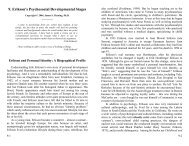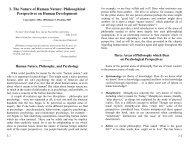7. Piaget, Kohlberg, Gilligan, and Others on Moral Development
7. Piaget, Kohlberg, Gilligan, and Others on Moral Development
7. Piaget, Kohlberg, Gilligan, and Others on Moral Development
Create successful ePaper yourself
Turn your PDF publications into a flip-book with our unique Google optimized e-Paper software.
• Stage 4. Maintaining social c<strong>on</strong>venti<strong>on</strong>s or “law <str<strong>on</strong>g>and</str<strong>on</strong>g> order” are<br />
brief but apt descripti<strong>on</strong>s of the fourth stage. This sense of<br />
order becomes generalized bey<strong>on</strong>d close others to society at<br />
large. The c<strong>on</strong>cept of “doing <strong>on</strong>e’s duty” is crucial here.<br />
Level III: Postc<strong>on</strong>venti<strong>on</strong>al <strong>Moral</strong>ity. At this level the<br />
emphasis is no l<strong>on</strong>ger <strong>on</strong> c<strong>on</strong>venti<strong>on</strong>al, societal st<str<strong>on</strong>g>and</str<strong>on</strong>g>ards of<br />
morality, but rather <strong>on</strong> pers<strong>on</strong>al or idealized principles.<br />
• Stage 5. This can be called the “social c<strong>on</strong>tract” stage. The<br />
underst<str<strong>on</strong>g>and</str<strong>on</strong>g>ing is that laws, rules, <str<strong>on</strong>g>and</str<strong>on</strong>g> regulati<strong>on</strong>s are created<br />
for the mutual benefit of all citizens. Laws that are unjust ought<br />
to be changed. People at this stage underst<str<strong>on</strong>g>and</str<strong>on</strong>g> <str<strong>on</strong>g>and</str<strong>on</strong>g> believe in<br />
democracy in acti<strong>on</strong>.<br />
• Stage 6. This is the stage of “universal ethical principles.”<br />
Right <str<strong>on</strong>g>and</str<strong>on</strong>g> wr<strong>on</strong>g are not determined by rules <str<strong>on</strong>g>and</str<strong>on</strong>g> laws, but by<br />
individual reflecti<strong>on</strong> <strong>on</strong> what is proper behavior. One might<br />
think here of Kant’s categorical imperative in which right <str<strong>on</strong>g>and</str<strong>on</strong>g><br />
wr<strong>on</strong>g apply equally to all, without regard to c<strong>on</strong>sequences<br />
(Chapter 3), except that modern ethicists underst<str<strong>on</strong>g>and</str<strong>on</strong>g> the<br />
importance of the situati<strong>on</strong>: What is wr<strong>on</strong>g in most<br />
circumstances (e.g., lying) might be justifiable in others. But<br />
essentially, pers<strong>on</strong>al ethical values (e.g., a belief that all life is<br />
sacred) take precedence over any <str<strong>on</strong>g>and</str<strong>on</strong>g> all laws <str<strong>on</strong>g>and</str<strong>on</strong>g> c<strong>on</strong>venti<strong>on</strong>s.<br />
In other words, laws are useful <strong>on</strong>ly as l<strong>on</strong>g as they serve the<br />
comm<strong>on</strong> good. Civil disobedience (such as the civil rights “sitins”<br />
in the 1960s) is justified by the circumstances (in this case<br />
segregati<strong>on</strong> of the races). As a biblical example, think of Jesus,<br />
who said in resp<strong>on</strong>se to the Pharisees that “The Sabbath was<br />
made for man, <str<strong>on</strong>g>and</str<strong>on</strong>g> not men for the Sabbath.” <str<strong>on</strong>g>Kohlberg</str<strong>on</strong>g><br />
believed that few people actually reach this stage, but those<br />
who do are of the stature of Moh<str<strong>on</strong>g>and</str<strong>on</strong>g>as G<str<strong>on</strong>g>and</str<strong>on</strong>g>hi or Martin<br />
Luther King, Jr.<br />
7-9<br />
Table <str<strong>on</strong>g>7.</str<strong>on</strong>g>1 shows some possible resp<strong>on</strong>ses to the “Heinz”<br />
dilemma, both pro (Heinz should steal the drug) <str<strong>on</strong>g>and</str<strong>on</strong>g> c<strong>on</strong> (Heinz<br />
should not steal the drug). At stage 6 no reas<strong>on</strong>able “c<strong>on</strong>” resp<strong>on</strong>se<br />
could be found for this particular dilemma. Note that these<br />
examples do not by any means exhaust the possibilities for<br />
children’s or adults’ rati<strong>on</strong>alizati<strong>on</strong>s for Heinz’s behavior.<br />
The examples in Table <str<strong>on</strong>g>7.</str<strong>on</strong>g>1 are reas<strong>on</strong>ably straight forward; in<br />
fact, they are simpler than the more elaborate answers normally<br />
given by children. It takes some training as well as familiarity with<br />
guidelines (of Colby & <str<strong>on</strong>g>Kohlberg</str<strong>on</strong>g>, 1987) to become facile at<br />
classifying children according to their narrative reports.<br />
<str<strong>on</strong>g>Kohlberg</str<strong>on</strong>g>’s theory is really <strong>on</strong>e of cognitive development (per<br />
<str<strong>on</strong>g>Piaget</str<strong>on</strong>g>) as applied to moral underst<str<strong>on</strong>g>and</str<strong>on</strong>g>ing because he believed that<br />
children developed their moral principles primarily though<br />
thinking about them. The progressi<strong>on</strong> through the stages cannot be<br />
accounted for by simple maturati<strong>on</strong> or development of the nervous<br />
system. The child must grapple with these moral issues as they<br />
arise, <str<strong>on</strong>g>and</str<strong>on</strong>g> as with <str<strong>on</strong>g>Piaget</str<strong>on</strong>g>, disequilibrium occurs; for instance, when<br />
a child realizes that punishment for an unintenti<strong>on</strong>al infracti<strong>on</strong><br />
seems somehow unfair. Nor did <str<strong>on</strong>g>Kohlberg</str<strong>on</strong>g> believe that moral<br />
underst<str<strong>on</strong>g>and</str<strong>on</strong>g>ing was primarily due to learning of social mores<br />
because neither parents nor peers can teach new modes of thinking.<br />
<str<strong>on</strong>g>Kohlberg</str<strong>on</strong>g>’s (1958) doctoral dissertati<strong>on</strong>, up<strong>on</strong> which he<br />
formulated his basic theory, studied 84 boys, most of whom he<br />
c<strong>on</strong>tinued to study over the next couple of decades in his<br />
l<strong>on</strong>gitudinal research. As a result of his <strong>on</strong>going research he<br />
refined his methodology. He also dropped the sixth stage from his<br />
research program because so few people ever seem to reach this<br />
stage. Thus although this stage is not well-studied, it still retains<br />
some theoretical interest. But it is well to remember that the<br />
average pers<strong>on</strong> does not even attain the fifth stage;<br />
postc<strong>on</strong>venti<strong>on</strong>al morality is rare, even am<strong>on</strong>g adults.<br />
Although research generally supports <str<strong>on</strong>g>Kohlberg</str<strong>on</strong>g>’s stage theory<br />
insofar as children’s underst<str<strong>on</strong>g>and</str<strong>on</strong>g>ing of morality is c<strong>on</strong>cerned there<br />
are some notable excepti<strong>on</strong>s.<br />
7-10




